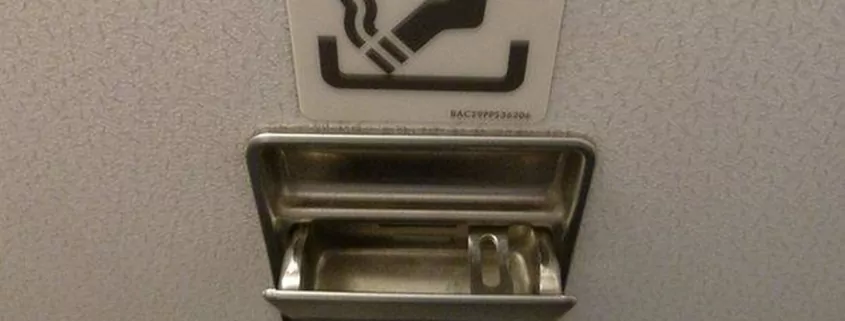Why Airplanes Still Have Ashtrays When Smoking Is Banned?
It’s a common observation for many air travelers, whether seasoned flyers or occasional vacationers: nestled somewhere onboard, often in or near the lavatory, sits an ashtray. This small feature might seem like a curious relic from a bygone era, especially given the strict, universally enforced bans on smoking during flights that have been in place for decades. The lingering presence of these ashtrays sparks a natural question: if lighting up mid-flight is strictly forbidden and carries hefty penalties, why do even brand-new airplanes still come equipped with them? The answer lies not in condoning smoking, but firmly in the realm of passenger safety and regulatory foresight.
The End of an Era: Grounding In-Flight Smoking
For those who flew regularly before the turn of the millennium, the memory of designated smoking sections onboard aircraft might still linger. Smoking was once commonplace in the skies, generally permitted except during takeoff and landing. However, growing awareness of the health risks associated with secondhand smoke, coupled with concerns about fire hazards in enclosed spaces, led to a gradual phasing out of in-flight smoking.
The movement gained momentum through the late 20th century. Pioneering airlines like Scotland’s Loganair implemented bans as early as 1980, and United Airlines introduced smoke-free sections in the US during the 1970s. Regulatory bodies began stepping in as well. In the US, legislation progressively restricted smoking on domestic flights – first on flights under two hours (1988), then expanding to those under six hours (1990). The final nail in the coffin for legal in-flight smoking in the US came in 2000, when President Bill Clinton signed a law banning it entirely on all domestic and international flights to and from the country.
Similar timelines unfolded globally. British Airways, for instance, trialed bans in 1990 before fully prohibiting smoking on all flights by March 1998. A tragic incident in 1998, where a passenger reportedly suffered a fatal anaphylactic reaction to cigarette smoke on an Olympic Airways flight, further underscored the health risks in a confined cabin environment. By the early 2000s, virtually every major airline worldwide had implemented a complete ban, prioritizing the health of passengers and crew and significantly mitigating fire risks.

The Lingering Ashtray: A Mandatory Safety Feature
Despite the comprehensive bans, illuminated “No Smoking” signs, and pre-flight announcements explicitly prohibiting smoking and vaping, aviation authorities like the Federal Aviation Administration (FAA) in the United States and the Civil Aviation Authority (CAA) in the UK still mandate the inclusion of ashtrays, particularly in or near aircraft lavatories. This isn’t an oversight or a nostalgic nod to the past; it’s a deliberate and legally required safety measure.
Why? The simple, albeit frustrating, reason is that despite clear rules, warnings, and severe penalties, some passengers still attempt to smoke illegally during flights. The FAA and other regulators recognize this stubborn reality. Their primary concern is preventing an in-flight fire, one of the most dangerous emergencies that can occur on an aircraft.
If a passenger disregards the rules and lights a cigarette (often illicitly in the lavatory), they will eventually need to extinguish it. Without a designated, safe receptacle, the high probability, based on past incidents, is that the lit cigarette might be disposed of improperly – potentially into a waste bin filled with flammable paper towels or other trash. This exact scenario is believed to be a potential cause of a catastrophic fire.
“The installation of an ashtray on or near the lavatory door will ensure that uninformed persons who find themselves with lighted smoking materials on the airplane will have an obvious location to dispose of smoking materials before entering the lavatory,” the FAA says.
“The installation of an ashtray on or near the lavatory door will ensure that uninformed persons who find themselves with lighted smoking materials on the airplane will have an obvious location to dispose of smoking materials before entering the lavatory,” the FAA says.

A Stark Reminder: The Varig Flight 820 Tragedy
The danger of improper cigarette disposal isn’t merely theoretical. A tragic incident in 1973 serves as a grim reminder. Varig Flight 820, flying from Rio de Janeiro to Paris, experienced a fire that started in one of the aircraft’s lavatories. Smoke quickly filled the cabin, forcing an emergency landing in a field just outside Paris Orly Airport. Tragically, 123 people lost their lives, with only 11 survivors. While the exact cause couldn’t be definitively proven, investigators strongly suspected the fire originated from a cigarette improperly extinguished in the lavatory’s waste bin.
This disaster, among others potentially linked to smoking materials, heavily influenced safety regulations. The mandatory ashtray provides a designated, fire-contained place to safely extinguish a cigarette, minimizing the risk of a rule-breaking passenger inadvertently starting a catastrophic fire by using the trash bin.
Not an Invitation: Strict Enforcement and Penalties
It is crucial to understand that the presence of an ashtray does not, in any way, imply permission or tolerance for smoking or vaping onboard. Aviation authorities and airlines take violations extremely seriously. The “No Smoking” signs remain illuminated, and cabin crew are vigilant.
Passengers caught smoking or vaping face severe consequences. These can include:
- Steep Fines: Financial penalties can be substantial. In the UK, fines can reach £5,000. In the US, the FAA can propose civil penalties up to $37,000 per violation for “unruly passenger” behavior, which includes smoking.
- Airline Bans: Airlines may ban offenders from flying with them in the future.
- Criminal Charges: In some jurisdictions, particularly the US, smoking on a flight can lead to criminal charges, potentially involving law enforcement agencies like the FBI upon landing.
- Flight Diversions: In serious cases, the flight may be diverted to the nearest airport to remove the offending passenger.
As one experienced cabin crew member, formerly a firefighter, emphasized, “What people don’t understand is that a fire on board is one of the most scary things to have.” The rules are in place for the safety of everyone onboard.

Conclusion: Safety Over Sentiment
So, the next time you spot an ashtray on an airplane, remember it’s not a forgotten remnant or a subtle invitation. It’s a mandated safety feature, required by aviation regulators globally as a crucial precaution. It exists solely to provide a safe means of extinguishing smoking materials should someone decide to break the law, thereby reducing the potentially catastrophic risk of an in-flight fire started by improper disposal. Ashtrays are considered “minimum equipment” by agencies like the FAA, and if one is broken, flights can even be delayed until it’s replaced, as demonstrated by a reported British Airways incident in 2009. While smoking has long been grounded, the ashtray remains airborne as a small but vital component of passenger safety protocols, acknowledging the unfortunate reality that rules are sometimes broken.
For smokers traveling by air, the only safe and legal approach is to refrain entirely during the flight and utilize alternatives like nicotine patches or gum if needed, obtained well before boarding.
- Malaysia Negeri Sembilan Backs Vape Ban, Awaits Clear Laws - August 5, 2025
- Is It Illegal to Vape or Smoke While Driving in Massachusetts? - August 5, 2025
- Austria Plans to Ban Disposable E-Cigarettes - August 5, 2025







